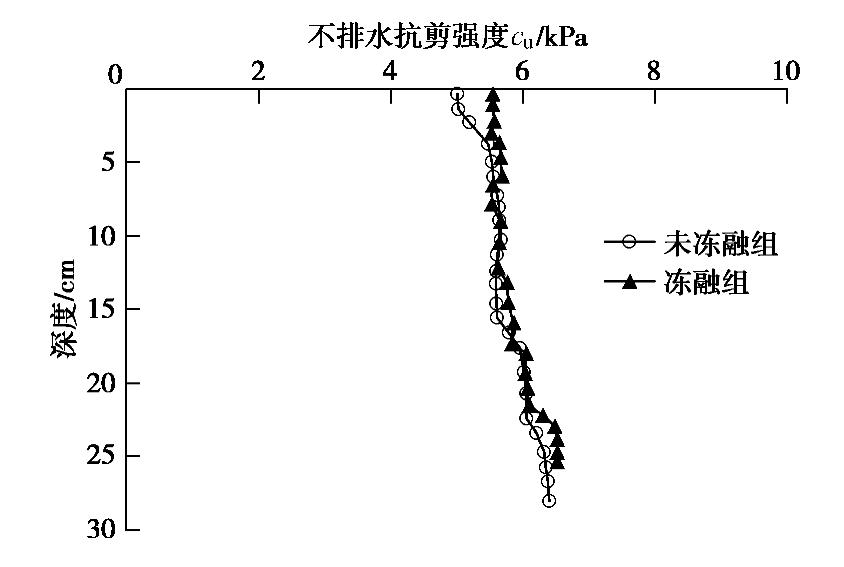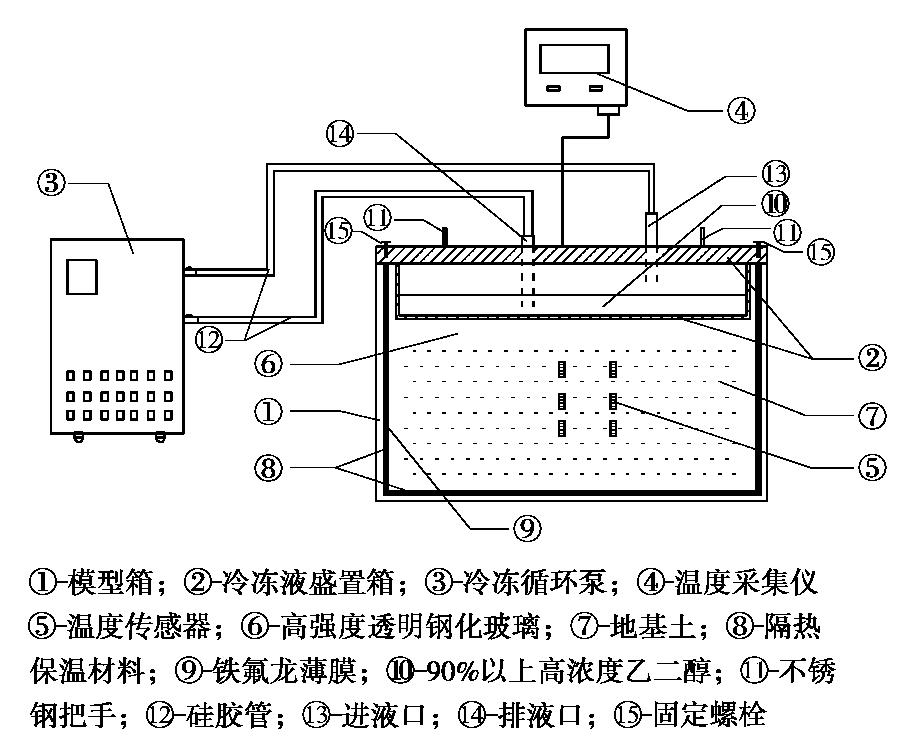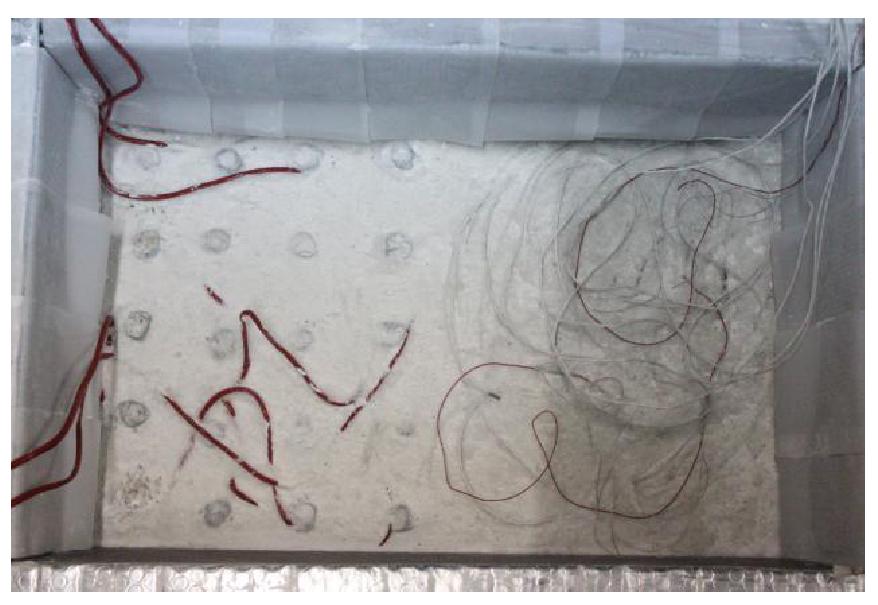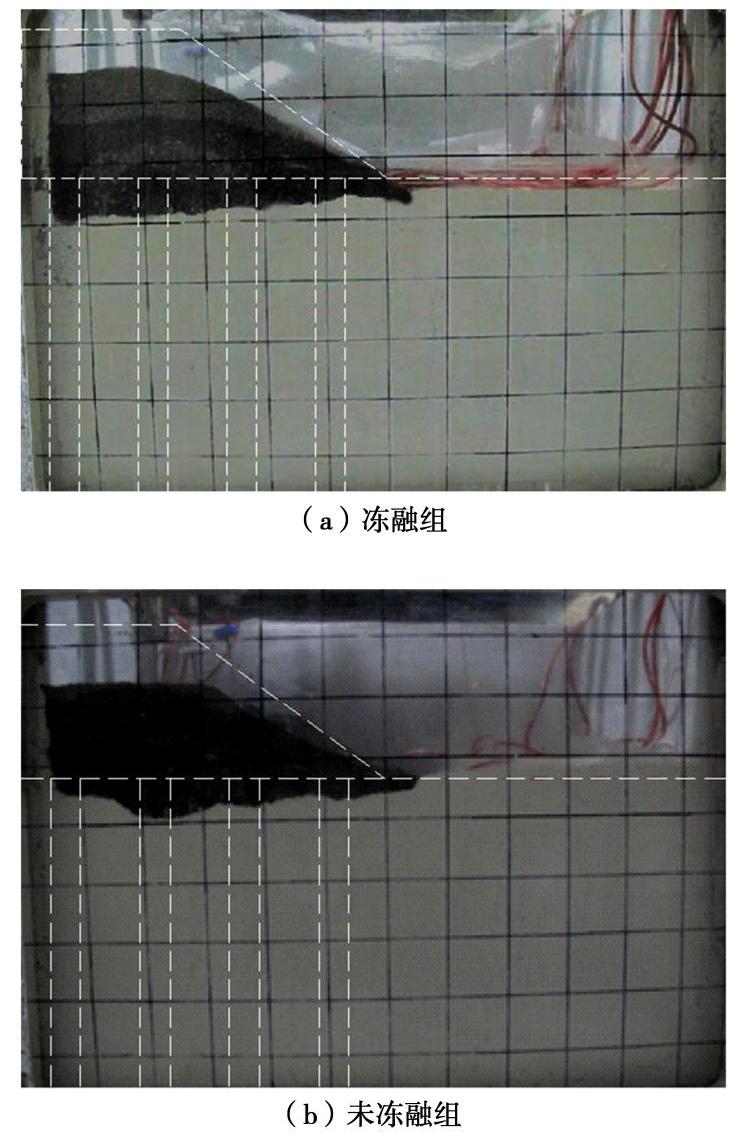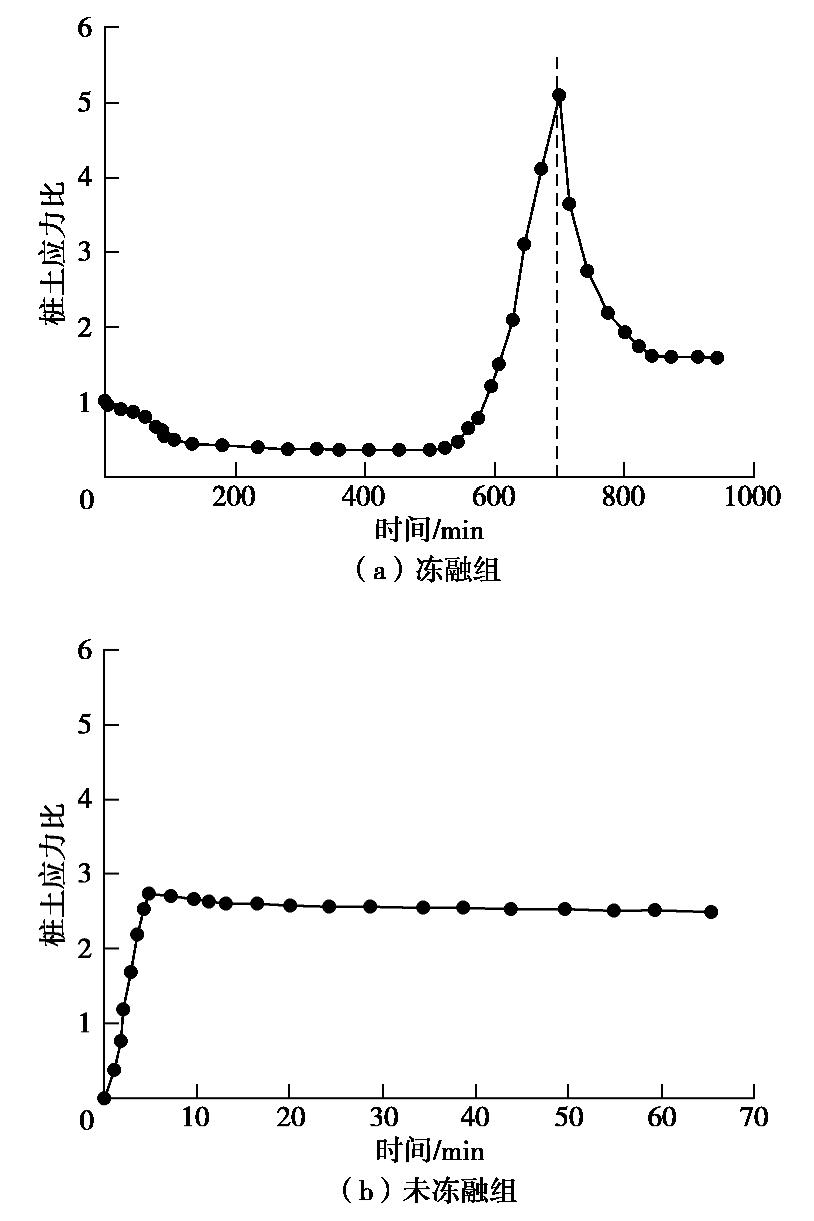Behaviour of embankment on composite foundation with geosynthetic-encased stone columns under freeze-thaw condition
-
摘要: 制作了一套加筋碎石桩复合地基冷冻试验系统,开展了1组加筋碎石桩复合地基路堤冻融离心模型试验和1组未冻融的对比试验,以研究加筋碎石桩复合地基经历季节性冻土后填筑的路堤在冻融条件下的性状。研究结果表明:冻融条件下加筋碎石桩复合地基在地基土未融化前,其桩顶和桩间土沉降基本一致,而在地基土全部融化后,桩间土沉降显著增大;冻融条件下路堤边坡基本保持初始坡度,路堤下地基沉降比较均匀,而未冻融组路堤边坡明显变缓,路堤下地基不均匀沉降明显;在复合地基和桩体均处于冰冻状态时,其桩顶和桩间土应力一致,当桩体先于桩间土融化后,桩顶应力减小而桩间土应力增大,而当地基土开始全部融化后,桩间土应力快速下降而桩顶应力快速增大,冻融条件下复合地基沉降稳定时的桩土应力比是未冻融条件下桩土应力比的2/3左右;冻融条件下由于路堤加载过程中桩顶周围土体处于冰冻状态,限制了桩顶侧向位移,而冻土层以下土体推动下部桩体向外位移,使得靠近路堤边坡下的桩体向路堤内弯曲,但弯曲变形量较小,而未冻融条件下的桩体则向路堤外弯曲且弯曲变形量较大;加筋碎石桩适合用于季节性冻土区湿地软土地基处理,其复合地基经历季节性冻土后填筑的路堤整体性能较好。Abstract: A set of freezing test system for composite foundation with geosynthetic-encased stone columns (GESCs) is developed. The centrifugal model tests are conducted on an embankment on composite foundation with GESCs under freeze-thaw condition, and the comparative tests under non-freezing condition are also conducted. The behavior of embankment built on composite foundation with GESCs subjected to seasonal freezing is studied under freeze-thaw condition. The results show that under freeze-thaw condition, the consistent settlement is found on the top of the columns and on the soil when the soil and the columns are in the frozen state, while that on the soil increases significantly after complete melting. The embankment slope remains the original slope angle and has relatively uniform settlement under freeze-thaw condition, while the significant decrease in slope angle and differential settlement are observed under non-freezing condition. When the soil and the columns are in the frozen state, the stresses on the top of the columns and on the soil between the columns are consistent. However, columns melt before the soil, the stress on the top of the columns decreases while that on the soil increases. After the soil melts completely, the stress on the soil decreases rapidly while that on the top of the columns increases rapidly. Under the freeze-thaw condition, the stress concentration ratio is relatively small, which is about 2/3 of that under non-freezing condition. Because the soil around the top of the columns is in a frozen state during the embankment loading, the lateral displacement of the top of the columns is restricted. However, the soil below the frozen soil layer pushes the lower part of the columns outward that makes the columns under the embankment slope bend inward, but small bending deformation is observed. Inversely, the columns bend outward under non-freezing condition, and the bending deformation is obvious. The GESCs are suitable for the soft soil foundation treatment of wetlands in the seasonal frozen soil areas, and the overall performance of embankment built on the composite foundation with GESCs subjected to seasonal freezing is satisfactory.
-
0. 引言
加筋碎石桩又称为土工织物散体桩,是在土工合成材料套筒内填充碎石、砾石、砂等散体材料,从而可显著提高其在软土地基中的承载能力,减少地基的沉降量,同时还可保持很好的竖向排水能力[1-3]。加筋碎石桩已在软土地基路堤和堤坝工程中得到成功应用[1]。
目前国内外学者对加筋碎石桩复合地基路堤已开展了一些研究工作,但多数研究集中于采用数值模拟手段分析不同参数对复合地基路堤性状的影响[4-10],而有关的试验研究还比较少。Almeida等[11]开展了加筋碎石桩复合地基路堤现场试验,分析了桩土应力比和差异沉降量的变化规律。赵明华等[12]、Gu等[13]通过室内模型试验研究了套管长度对加筋碎石桩侧向和竖向变形以及破坏模式的影响。陈建峰等[2,14]开展了不同筋材刚度的加筋碎石桩复合地基路堤模型试验,得出在路堤荷载下加筋碎石桩复合地基的沉降随筋材刚度的增大而显著减小,且路堤边坡下的桩体发生向外的弯曲变形,而没有出现剪切滑移趋势。Fattah等[15]开展了加筋碎石桩复合地基路堤模型试验,得出复合地基承载比随桩体长径比或桩间距的减小而增大。
在中国东北、华北和西北广泛的季节性冻土区分布有不少湿地保护区,在这些保护区中进行道路工程建设势必要采用地基处理技术。由于黏结材料桩(如水泥土桩、混凝土桩等)会影响湿地土质、水质或地下水渗流环境,因此采用加筋碎石桩来处理湿地软土地基处理是一个选择,如横穿呼伦贝尔核心保护区的内蒙古S203省道满州里至阿木古郎一级公路跨越约7 km的湿地,拟采用加筋碎石桩对其进行处理。然而已有的对加筋碎石桩复合地基路堤的研究均未考虑季节性冻土区冻融条件的影响。
一些学者已对路基或地基在冻融条件下的性状开展了研究工作。梁波等[16]结合青藏铁路清水河、北麓河试验段土质条件,通过室内试验探讨和研究了不同土质在不同含水率、密实度、荷载条件下反复冻融过程中的融沉特性。王天亮等[17]以青藏铁路那曲物流中心站场路基填料为研究对象,通过室内试验研究和分析了压实度、荷载以及冻融次数对土体融沉性质的影响规律。张玉芝等[18]考虑冰水相变的作用,采用热弹性力学理论推导出冻土路基应力和变形的二维数值方程,建立路基力学有限元模型,研究了哈大高速铁路路基冻融过程中的变形和应力分布规律。陈湘生等[19]尝试了地基经受两个冻融循环的离心模型试验,得出在有压和无压时地基冻胀形态不同,而模型内温度分布与实际吻合。Zhou等[20]对人工冻土进行了一系列冻融离心模型试验,结果表明,离心加速度下冻土的解冻率较1g下小试样冻土的解冻率更高,且其融化锋面较天然冻土发展得更快。蔡正银等[21]阐述了冻土离心模型试验装置的发展过程、已开展的主要试验及研究成果,并展望了冻土离心模拟技术未来的发展方向。
本文开展了1组加筋碎石桩复合地基路堤冻融离心模型试验,并开展了1组未冻融的对比试验,以研究加筋碎石桩复合地基经历季节性冻土后填筑的路堤在冻融条件下的性状。
1. 离心模型试验
1.1 模型设计
本次试验采用同济大学150g·t复合型土工离心机。模拟对象路堤高度为4.5 m,顶宽为4.2 m,坡率为1∶1.2,软土地基厚度为9 m,桩体采用筋材套筒通长加筋,桩长为9 m,桩径为0.8 m,桩间距为2.5 m,正方形布桩。模型箱的有效内部尺寸为600 mm×400 mm×500 mm(长×宽×高)。季节性冻土深度设为1.9 m。本次试验取模型比N=32。图1为缩尺后的模型尺寸。共设计制备了1组冻融和1组未冻融加筋碎石桩复合地基路堤离心模型。冻融试验组模拟的工况是加筋碎石桩复合地基经历季节性冻土后填筑路堤,而后地基融化。
1.2 模型材料及制备
(1)地基土
模型地基土选用粒径为0.018 mm(800目)高岭土制备。高岭土的液限wL为54.2%,塑限wp为34.3%,塑性指数IP为19.9,饱和重度
γsat 为17.8 kN/m3。三轴固结不排水试验测得其有效黏聚力c′ 为0,有效内摩擦角φ′ =27.7°。(2)路堤填土
路堤填土采用粒径为0.5~2 mm的铁矿砂,其最大和最小干密度分别为2.4,1.8 g/cm3。路堤填筑密度控制为2.2 g/cm3,含水率为4%。直剪试验测得其黏聚力c=0,内摩擦角ϕ=44°。
(3)桩体材料
桩体材料采用粒径为2.5~3 mm的石英砂,其不均匀系数Cu=1.891,曲率系数Cc=0.857,平均粒径d50=2.64 mm,最大和最小干密度分别为1.85,1.60 g/cm3,制作的模型桩桩体的密度控制为1.75 g/cm3,即压实系数达到95%。通过直剪试验获得其黏聚力c=0,内摩擦角ϕ=38°。
(4)模型筋材
选取尼龙灰窗纱作为模型筋材,其抗拉强度为2.5 kN/m,5%拉伸率时的拉伸力为0.9 kN/m,筋材刚度(5%拉伸率时拉伸力与拉伸率之比)为18 kN/m。模型筋材还原为原型时的强度和刚度分别为80,576 kN/m。
1.3 试验过程
(1)制备模型地基土
将高岭土和水以质量比1∶1混合搅拌均匀,倒入内壁贴有两层聚四氟乙烯膜的模型箱内,而后在32g离心加速度下固结2 h。采用小型静力触探仪[14]对固结后的地基土进行贯入试验,图2为冻融组和未冻融组试验地基土不排水抗剪强度cu沿深度分布曲线,可见两者土性接近,cu约为6 kPa。
(2)打设加筋碎石桩
首先将预钻好桩位孔的定位板置于模型地基土表面,而后将抹了润滑油的外径25 mm,壁厚0.8 mm的无缝薄壁钢管从桩位孔中压入到地基土内,采用螺旋取土器取出管内的土体,接着将缝制好的筋材套筒放入钢管内,灌入石英砂,每灌入5 cm左右用击实杆击实40下,使桩体达到其控制密度1.75 g/cm3。重复此步骤直到桩体施作完成。
(3)布置测量仪器
靠近路堤中心线附近地基土表面布置2个BWM型土压力计,量程为300 kPa,精度为2级,其中土压力计t1布置在桩顶,土压力计t2布置在桩间土上。在桩顶和桩间土上各埋设1个沉降标(w1、w2)。对于冻融组,在路堤以外地基土中布置2个热电偶温度传感器(T1、T2),其测温范围-50℃~200℃,精度为±0.1℃,埋设深度分别距地表3,6 cm,以监测冻融时的温度。具体布置见图1所示。
(4)冷冻地基土
冷冻设备采用上海互佳仪器厂生产的型号为DLSB-30/80低温冷却液循环泵,其制冷温度范围为-80℃~40℃,精度为±0.2℃。
制作了一套加筋碎石桩复合地基冷冻试验系统,如图3所示。采用该系统对加筋碎石桩复合地基进行冷冻,当温度传感器T2监测的温度达到0℃左右时,停止冷冻,此时冷冻深度距地表6 cm左右,相当于原型冻土深度1.9 m左右。冷冻完成后的加筋碎石桩复合地基如图4所示。
(5)进行离心模型试验
采用铁矿砂填筑路堤,其密度控制为2.2 g/cm3。将填筑好路堤的模型箱置于离心机上,连接好传感器、相机线路后开始试验。
2组试验均在5 min内将离心加速度加至32g,而后冻融组试验保持32g运转至1000 min结束,未冻融组试验保持32g运转至70 min结束。
2. 结果分析
2.1 路堤变形
图5为试验结束时2组试验的路堤变形图,图中采用虚线标出了运转前路堤和桩体轮廓图。由图5可见,冻融组复合地基沉降呈现路堤中心附近以下较大而边坡下有所减小。从冻融组路堤外地基表面沉降看,地基产生了融沉,其值约为8 mm;而未冻融组路堤外地基表面则产生隆起,隆起最大值约为20 mm。冻融组路堤边坡基本保持初始坡度,路堤下地基沉降比较均匀;而未冻融组路堤边坡明显变缓,路堤下地基不均匀沉降明显。这与两者的加筋碎石桩桩体变形差异相关,将在2.3节中作进一步讨论。
图6为2组试验中布置在桩顶的沉降标w1点和布置在桩间土上沉降标w2点测得的沉降随时间变化曲线。由图6(a)可见,冻融组在约500 min之内的加载和休止期间其桩顶和桩间土沉降基本一致,而从500 min开始桩间土沉降大于桩顶沉降,到700 min左右桩顶和桩间土沉降开始趋于稳定。
500 min开始桩间土沉降大于桩顶沉降的原因是此时路堤下冻土开始全部融化。图7为埋设于路堤外距地基土表面3,6 cm深度T1和T2温度传感器监测的地基土温度变化曲线,可以看到,T1温度在440 min左右从零度以下升至约0.2℃,而后很快升高,T2传感器温度则在500 min左右开始很快升高。
由图6(b)可见,未冻融组在加载期和休止期的桩间土沉降均显著大于桩顶沉降,且桩顶和桩间土沉降在加载期即已完成了大部分的沉降,这是由于加筋碎石桩在软土中具有很好的排水性能[2,12]。
表1列出了冻融组和未冻融组在加载期末和休止期末桩顶和桩间土沉降值及沉降差值。可以看到,在休止期末,冻融组桩顶和桩间土沉降分别达到42,54 mm,分别是未冻融组桩顶和桩间土沉降的1.9倍和1.3倍左右。而冻融组在加载期末和休止期末的桩顶和桩间土差异沉降分别为2,12 mm,均明显小于未冻融组情况。
表 1 桩顶和桩间土沉降Table 1. Settlements on top of columns and soil(mm) 试验 桩顶沉降 桩间土沉降 差异沉降 加载期末 休止期末 加载期末 休止期末 加载期末 休止期末 冻融组 12 42 14 54 2 12 未冻融组 19 22 37 42 18 20 2.2 桩土应力
图8为2组试验桩顶和桩间土应力随时间变化曲线图。由图8(a)可见,冻融组在加载期桩顶和桩间土应力几乎同步升至100 kPa左右,这与4.5 m高原型路堤自重应力99 kPa一致。从休止期初开始至500 min,桩间土应力变大,而桩顶应力变小。其原因应是桩体碎石导热率高于桩间土,桩体先于桩间土融化,导致桩体模量降低所致。
笔者[23]曾开展了加筋碎石桩桩体大三轴试验,得出了桩体模量
Ep 统计回归公式如下:Ep=κ(Pr1+TR)tan2(45°。 (1) 式中 T为筋材拉伸强度(kN/m);R为桩体直径(m);κ为桩体模量修正系数,取1.90;ϕ为填料内摩擦角(°);
为筋材拉伸强度对应的拉伸率; 为桩周侧向有效应力(kPa)。 对本问题的原型,如1.2节所述,T=80 kN/m,R=0.8m,ϕ=38°,
19%。桩顶的Pr1可取为0,桩端(9 m深度)的Pr1约为70 kPa。则按式(1),可以得到桩顶的桩体模量Ep=4.23 MPa,桩端的桩身模量Ep=7.15 MPa,这可看作桩体融化后的模量。参照文献[24]与本文相同塑性指数的黏性土冻土模量,本文未融化的桩间土的模量可以达到9 MPa左右,均较融化后的桩顶和桩端处桩体的模量高。因此,在休止期初开始至500 min期间,上覆路堤自重应力从融化后的桩体向未融化的桩间土转移。 500~700 min,桩间土应力快速下降,而桩顶应力快速增大,这是由于此阶段桩间土开始全部融化,桩间土模量急剧降低,使得上覆路堤应力又很快向桩体转移。700 min后桩顶应力有所减小,而桩间土应力反过来增大,这是由于桩间土固结后模量增大所致。
由图8(b)可见,未冻融组桩顶应力在加载期末达到最大,休止期略减小后趋于稳定,桩间土应力相对较小并在休止期趋于稳定。
图9为2组试验桩土应力比–时间曲线。由图9可见,冻融组桩土应力比从加载期的1,降低至500 min时的0.35左右,而后增大至700 min时的5.1左右,再降低并稳定在1.6左右。未冻融组的桩土应力比在加载期末达到2.7左右,休止期末稳定在2.5左右。可见,冻融组休止期末的桩土应力比较小,约为未冻融组的2/3左右。
2.3 桩体变形
试验结束后挖除桩周土体以便观察桩体变形。图10为2组试验桩体变形图。由图可见,两者路堤中心的#1桩体基本保持垂直状态,而靠近路堤边坡下的#2,#3,#4桩体均发生弯曲变形,但两者弯曲变形量和弯曲方向均不同。未冻融组桩体向路堤外弯曲,并产生明显的弯曲变形量,这与以往研究结果一致[2,10];而冻融组桩体向路堤内弯曲,且弯曲变形量较小,这是由于路堤加载过程中桩顶附近复合地基土处于冰冻状态,限制了桩顶侧向位移,而冻土层以下的土体向外位移,推动下部桩体向外位移。
图5中冻融组和未冻融组路堤和地基土变形性状不同,即与两者路堤下的桩体弯曲变形量和弯曲方向不同有关系。冻融组桩体向内弯曲且弯曲变形量小,使得其上路堤能基本保持堆载时的形状,其复合地基沉降也较均匀;同时路堤中心附近较路堤边坡的荷载大,因而前者的沉降也较后者大一些。未冻融组桩体由于产生向外明显弯曲,使得路堤填土向外扩散,坡度降低,其复合地基土沉降亦相对不均匀。
3. 结论
本文制作了一套加筋碎石桩复合地基冷冻试验系统,开展了一组加筋碎石桩复合地基路堤冻融离心模型试验和一组未冻融的对比试验,以研究加筋碎石桩复合地基经历季节性冻土后填筑的路堤在冻融条件下的性状。得出如下结论:
(1)冻融条件下加筋碎石桩复合地基在地基土未融化前,其桩顶和桩间土沉降基本一致;地基土全部融化后,桩间土沉降变大。冻融条件下路堤边坡基本保持初始坡度,路堤下地基沉降比较均匀;而未冻融组路堤边坡明显变缓,路堤下地基不均匀沉降明显。
(2)冻融条件下加筋碎石桩复合地基路堤在地基和桩体均处于冰冻状态时,其桩顶和桩间土应力一致;在桩体先于桩间土融化后,桩体模量降低,桩顶应力开始向桩间土转移,导致桩顶应力小于桩间土应力;在桩间土全部融化后,桩间土模量很快降低,使得桩间土应力快速下降,而桩顶应力快速增大。冻融条件下复合地基沉降稳定时的桩土应力比为1.6,是未冻融条件下桩土应力比的2/3左右。
(3)冻融条件下,由于路堤加载过程中桩顶周围地基土处于冰冻状态,限制了桩顶侧向位移,而冻土层以下土体推动下部桩体向外位移,使得靠近路堤边坡下的桩体向路堤内弯曲,但弯曲变形量较小。未冻融条件下的桩体则向路堤外弯曲且弯曲变形量较大。
(4)加筋碎石桩适合用于季节性冻土区湿地软土地基处理,其复合地基经历季节性冻土后填筑的路堤整体性能较好。
-
表 1 桩顶和桩间土沉降
Table 1 Settlements on top of columns and soil
(mm) 试验 桩顶沉降 桩间土沉降 差异沉降 加载期末 休止期末 加载期末 休止期末 加载期末 休止期末 冻融组 12 42 14 54 2 12 未冻融组 19 22 37 42 18 20 -
[1] ALEXIEW D, BROKEMPER D, LOTHSPEICH S. Geotextile encased columns (GEC): load capacity, geotextile selection and pre-design graphs[C]//Proceedings of the Geo-frontiers Conference, 2005, Austin: 497-510.
[2] 陈建峰, 李良勇, 徐超, 等. 路堤荷载下土工织物散体桩复合地基离心模型试验[J]. 岩土工程学报, 2018, 40(5): 932-938. https://www.cnki.com.cn/Article/CJFDTOTAL-YTGC201805023.htm CHEN Jian-feng, LI Liang-yong, XU Chao, et al. Centrifuge model tests of composite foundation reinforced with geosynthetic-encased stone columns under embankment load[J]. Chinese Journal of Geotechnical Engineering, 2018, 40(5): 932-938. (in Chinese) https://www.cnki.com.cn/Article/CJFDTOTAL-YTGC201805023.htm
[3] LO S R, ZHANG R, MAK J. Geosynthetic-encased stone columns in soft clay: a numerical study[J]. Geotextiles and Geomembranes, 2010, 28(3): 292-302. doi: 10.1016/j.geotexmem.2009.09.015
[4] YOO C. Performance of geosynthetic-encased stone columns in embankment construction: numerical investigation[J]. Journal of Geotechnical and Geoenvironmental Engineering, 2010, 136(8): 1148-1160. doi: 10.1061/(ASCE)GT.1943-5606.0000316
[5] ELSAWY M B D. Behaviour of soft ground improved by conventional and geogrid-encased stone columns, based on FEM study[J]. Geosynthetics International, 2013, 20(4): 276-285. doi: 10.1680/gein.13.00017
[6] RAJESH S, JAIN P. Influence of permeability of soft clay on the efficiency of stone columns and geosynthetic-encased stone columns–a numerical study[J]. International Journal of Geotechnical Engineering, 2015, 9(5): 483-493. doi: 10.1179/1939787914Y.0000000088
[7] YOO C. Settlement behavior of embankment on geosynthetic-encased stone column installed soft ground: a numerical investigation[J]. Geotextiles and Geomembranes, 2015, 43(6): 484-492. doi: 10.1016/j.geotexmem.2015.07.014
[8] RAJESH S. Time-dependent behaviour of fully and partially penetrated geosynthetic encased stone columns[J]. Geosynthetics International, 2016, 24(1): 1-12.
[9] MOHAPATRA S R, RAJAGOPAL K. Undrained stability analysis of embankments supported on geosynthetic encased granular columns[J]. Geosynthetics International, 2017, 24(5): 465-479. doi: 10.1680/jgein.17.00015
[10] CHEN J F, LI L Y, XUE J F, et al. Failure mechanism of geosynthetic-encased stone columns in soft soils under embankment[J]. Geotextiles and Geomembranes, 2015, 43(5): 424-431. doi: 10.1016/j.geotexmem.2015.04.016
[11] ALMEIDA M S S, HOSSEINPOUR I, RICCIO M, et al. Behavior of geotextile-encased granular columns supporting test embankment on soft deposit[J]. Journal of Geotechnical and Geoenvironmental Engineering, 2014, 141(3): 04014116.
[12] 赵明华, 顾美湘, 张玲, 等. 竖向土工加筋体对碎石桩承载变形影响的模型试验研究[J]. 岩土工程学报, 2014, 36(9): 1587-1593. https://www.cnki.com.cn/Article/CJFDTOTAL-YTGC201409006.htm ZHAO Ming-hua, GU Mei-xiang, ZHANG Ling, et al. Model tests on influence of vertical geosynthetic-encasement on performance of stone columns[J]. Chinese Journal of Geotechnical Engineering, 2014, 36(9): 1587-1593. (in Chinese) https://www.cnki.com.cn/Article/CJFDTOTAL-YTGC201409006.htm
[13] GU M, ZHAO M, ZHANG L, et al. Effects of geogrid encasement on lateral and vertical deformations of stone columns in model tests[J]. Geosynthetics International, 2015, 23(2): 100-112.
[14] 陈建峰, 王波, 魏静, 等. 加筋碎石桩复合地基路堤模型试验[J]. 中国公路学报, 2015, 28(9): 1-8. https://www.cnki.com.cn/Article/CJFDTOTAL-ZGGL201509002.htm CHEN Jian-feng, WANG Bo, FENG Shou-zhong, et al. Model tests of embankments on soft foundation reinforced with geosynthetic-encased stone columns[J]. China Journal of Highway and Transport, 2015, 28(9): 1-8. (in Chinese) https://www.cnki.com.cn/Article/CJFDTOTAL-ZGGL201509002.htm
[15] FATTAH M Y, ZABAR B S, HASSAN H A. Experimental analysis of embankment on ordinary and encased stone columns[J]. International Journal of Geomechanics, 2016, 16(4): 1-13.
[16] 梁波, 张贵生, 刘德仁. 冻融循环条件下土的融沉性质试验研究[J]. 岩土工程学报, 2006, 28(10): 1213-1217. doi: 10.3321/j.issn:1000-4548.2006.10.007 LIANG Bo, ZHANG Gui-sheng, LIU De-ren. Experimental study on thawing subsidence characters of permafrost under frost heaving and thawing circulation[J]. Chinese Journal of Geotechnical Engineering, 2006, 28(10): 1213-1217. (in Chinese) doi: 10.3321/j.issn:1000-4548.2006.10.007
[17] 王天亮, 卜建清, 王扬, 等. 多次冻融条件下土体的融沉性质研究[J]. 岩土工程学报, 2014, 36(4): 625-632. https://www.cnki.com.cn/Article/CJFDTOTAL-YTGC201404006.htm WANG Tian-liang, BU Jian-qing, WANG Yang, et al. Thaw subsidence properties of soils under repeated freeze-thaw cycles[J]. Chinese Journal of Geotechnical Engineering, 2014, 36(4): 625-632. (in Chinese) https://www.cnki.com.cn/Article/CJFDTOTAL-YTGC201404006.htm
[18] 张玉芝, 杜彦良, 孙宝臣, 等. 季节性冻土地区高速铁路路基冻融变形规律研究[J]. 岩石力学与工程学报, 2014, 33(12): 2546-2553. https://www.cnki.com.cn/Article/CJFDTOTAL-YSLX201412021.htm ZHANG Yu-zhi, DU Yan-liang, SUN Bao-chen, et al. Roadbed deformation of high-speed railway due to freezing-thawing process in seasonally frozen regions[J]. Chinese Journal of Rock Mechanics and Engineering, 2014, 33(12): 2546-2553. (in Chinese) https://www.cnki.com.cn/Article/CJFDTOTAL-YSLX201412021.htm
[19] 陈湘生, 濮家骝, 殷昆亭, 等. 地基冻–融循环离心模型试验研究[J]. 清华大学学报(自然科学版), 2002(4): 531-534. https://www.cnki.com.cn/Article/CJFDTOTAL-QHXB200204028.htm CHEN Xiang-sheng, PU Jia-liu, YIN Kun-ting, et al. Centrifuge modelling tests of foundation undergoing two cycles of frost heave and thaw sett lement[J]. Journal of Tsinghua University (Science & Technology), 2002(4): 531-534. (in Chinese) https://www.cnki.com.cn/Article/CJFDTOTAL-QHXB200204028.htm
[20] ZHOU J, TANG Y Q. Centrifuge experimental study of thaw settlement characteristics of mucky clay after artificial ground freezing[J]. Engineering Geology, 2015, 190: 98-108.
[21] 蔡正银, 张晨, 黄英豪. 冻土离心模拟技术研究进展[J]. 水利学报, 2017, 48(4): 398-407. https://www.cnki.com.cn/Article/CJFDTOTAL-SLXB201704003.htm CAI Zheng-yin, ZHANG Chen, HUANG Ying-hao. A review on the development of geotechnical centrifuge modeling technique on frozen ground engineering[J]. Journal of Hydraulic Engineering, 2017, 48(4): 398-407. (in Chinese) https://www.cnki.com.cn/Article/CJFDTOTAL-SLXB201704003.htm
[22] 陈建峰, 柳军修, 马君. 实验室用小型单桥静力触探探头的标定[J]. 同济大学学报(自然科学版), 2012, 40(4): 549-552, 588. https://www.cnki.com.cn/Article/CJFDTOTAL-TJDZ201204009.htm CHEN Jian-feng, LIU Jun-xiu, MA Jun. Calibration of a mniature cone penetrometer for geotechnicalmodel test[J]. Journal of Tongji University (Natural Science), 2012, 40(4): 549-552, 588. (in Chinese) https://www.cnki.com.cn/Article/CJFDTOTAL-TJDZ201204009.htm
[23] 陈建峰, 王兴涛, 曾岳, 等. 土工织物散体桩桩体大三轴试验研究[J]. 岩土工程学报, 2017, 39(12): 2212-2218. https://www.cnki.com.cn/Article/CJFDTOTAL-YTGC201712011.htm CHEN Jian-feng, WANG Xing-tao, ZENG Yue, et al. Large triaxial compression tests on geosynthetic-encased granular columns[J]. Chinese Journal of Geotechnical Engineering, 2017, 39(12): 2212-2218. (in Chinese) https://www.cnki.com.cn/Article/CJFDTOTAL-YTGC201712011.htm
[24] 王静, 刘寒冰, 吴春利. 冻融循环对不同塑性指数路基土弹性模量的影响研究[J]. 岩土力学, 2012, 33(12): 3665-3668. https://www.cnki.com.cn/Article/CJFDTOTAL-YTLX201212023.htm WANG Jing, LIU Han-bing, WU Chun-li. Influence of freeze-thaw cycles on elastic modulus of subgrade soil with different plasticity indices[J]. Rock and Soil Mechanics, 2012, 33(12): 3665-3668. (in Chinese) https://www.cnki.com.cn/Article/CJFDTOTAL-YTLX201212023.htm
-
期刊类型引用(9)
1. 裘友强,张留俊,刘洋,刘军勇,尹利华. “双碳”背景下公路软土地基处理技术研究进展. 水利水电技术(中英文). 2025(01): 113-131 .  百度学术
百度学术
2. 董庆贺,陈熙. 碎石桩在市政道路软土地基处理中的应用研究. 工程技术研究. 2024(10): 119-121 .  百度学术
百度学术
3. 李检保,罗正东,谢测坤,贺敏,梁斌. 竹筋格栅套筒碎石桩复合地基承载变形特性研究. 人民长江. 2023(07): 134-139+209 .  百度学术
百度学术
4. 郭跃飞,章本本,罗正东,谢测坤. 竹筋格栅套筒加筋碎石桩极限承载力计算. 公路. 2023(10): 111-117 .  百度学术
百度学术
5. 赵斌. 软土条件下高层建筑复合地基沉降长期预测算法. 工程机械与维修. 2022(04): 126-129 .  百度学术
百度学术
6. 徐文栋,李学丰,杨文伟. 碎石桩加固砂土地基数值模拟. 地基处理. 2022(04): 316-321 .  百度学术
百度学术
7. 曾祥胜,翟健梁,陈佳煜. 矿物掺合料对干拌水泥碎石桩力学性能的影响. 青海交通科技. 2022(05): 55-61 .  百度学术
百度学术
8. 谢超. 高密度电法在清花高速公路岩溶区勘察中的应用. 青海交通科技. 2022(05): 62-69 .  百度学术
百度学术
9. 谭鑫,胡政博,冯龙健,赵明华. 软土中碎石桩模型试验的三维离散–连续介质耦合数值模拟. 岩土工程学报. 2021(02): 347-355 .  本站查看
本站查看
其他类型引用(7)



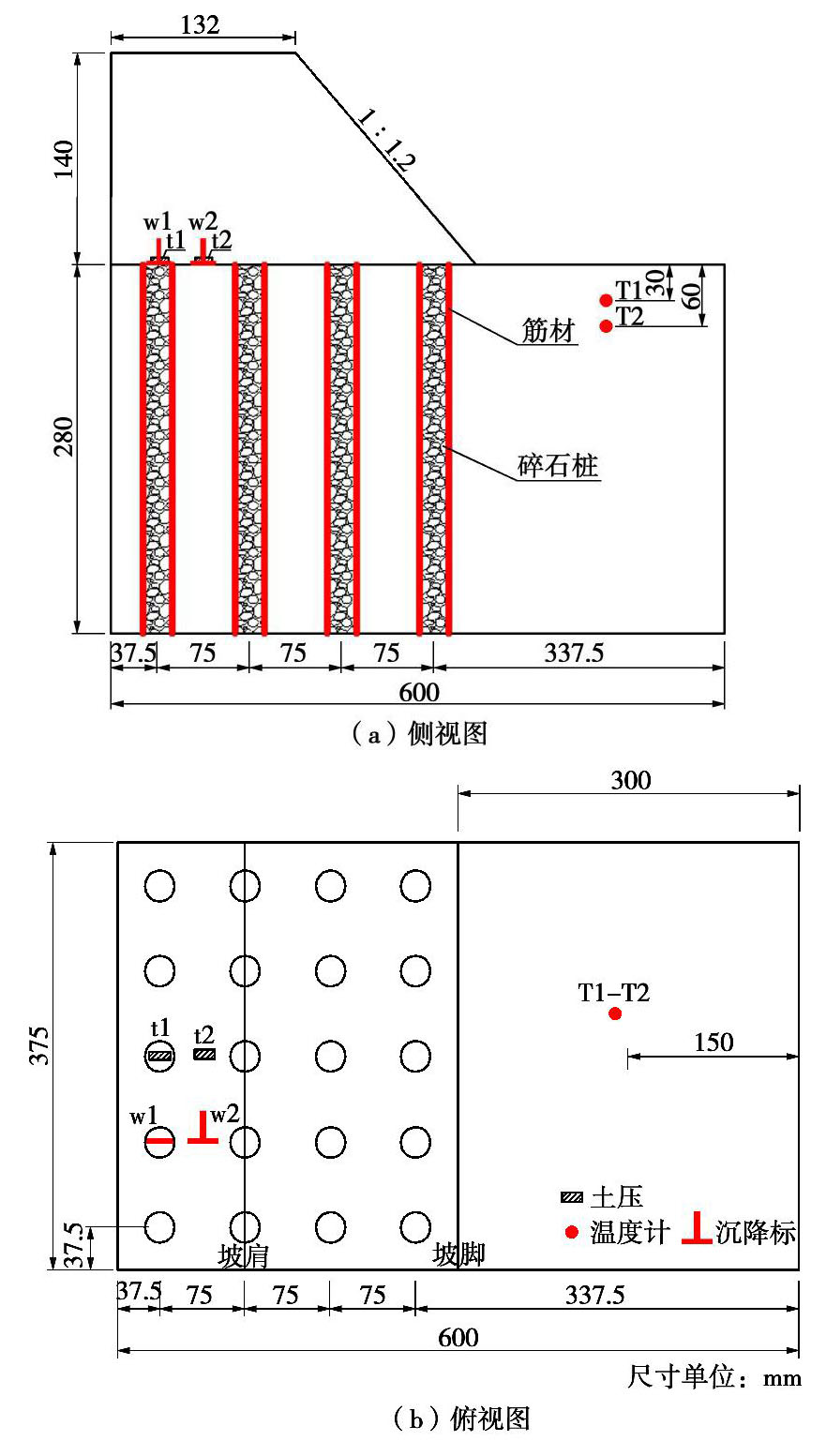
 下载:
下载:
